
One of the most visually captivating aspects of Diwali celebrations is the creation of intricate rangoli designs. These vibrant and colorful patterns adorn the entrances of homes, adding a touch of artistic beauty to the festival. In this blog, we’ll explore the art of rangoli and its significance during Diwali.
The Essence of Rangoli
Rangoli, derived from the Sanskrit word “rangavalli,” is a traditional Indian art form that involves creating intricate, geometric, and floral patterns on the ground or floor. It’s often made using colored powders, rice, flower petals, or even colored sand. Rangoli is more than just a decorative element; it’s a form of expression and a symbol of welcoming guests into one’s home.
Rangoli During Diwali
During Diwali, rangoli takes center stage as families and communities come together to create stunning designs outside their homes. The tradition of making rangoli dates back centuries and is believed to bring good luck and prosperity. It is also a way to honor Goddess Lakshmi, the goddess of wealth and prosperity, who is said to visit homes that are beautifully decorated during Diwali.
Varieties of Rangoli
Rangoli designs come in a wide array of patterns, colors, and styles. Some are simple and elegant, while others are incredibly intricate and time-consuming to create. Traditional motifs like lotus flowers, peacocks, and diyas are commonly incorporated into rangoli designs. Additionally, modern variations may include contemporary themes and creative interpretations.
The Process of Creation
Creating a rangoli design is a meticulous process that requires skill and patience. Artists start by drawing a rough outline of the design on the ground. Then, they fill it in with vibrant colors and intricate details, often using their fingers or specialized tools. The result is a visually stunning work of art that adds to the festive atmosphere.
A Symbol of Unity
Rangoli is more than just a decorative art; it’s a symbol of unity and togetherness. Families and communities often come together to create rangoli, fostering a sense of camaraderie and shared creativity. It’s a reminder that Diwali is not just about individual celebrations but also about spreading joy and positivity among loved ones and neighbors.
In conclusion, rangoli is a beautiful and meaningful tradition that enhances the beauty of Diwali celebrations. It’s a visual representation of the festival’s spirit—vibrant, colorful, and full of joy. So, the next time you see a stunning rangoli design during Diwali, take a moment to appreciate the artistry and the deeper significance it holds in this cherished festival.







